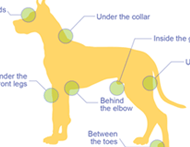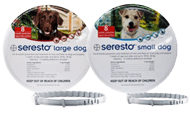Does Your Dog Have Ticks?

Frontline® Plus for Dogs
Topical control and treatment killing all stages of fleas and ticks for 30 days.
Seresto® Flea & Tick Collar for Dogs
Protect your dog against fleas and ticks continuously for 8 months.
When the hot summer months arrive, so do the pesky, blood-sucking ticks who like to climb in your pet’s fur. Ticks carry various diseases which can lead to illness and even death for dogs. Some tick-borne diseases, such as Lyme disease, are infectious to humans as well! It is important to stock up on your tick preventative supplies and keep a close watch on your pet’s condition during the summer. You should also pay attention to your home and surroundings, as ticks may get inside your home and spread diseases to your other pets. If you notice any of the following signs, there’s a chance your dog has ticks.
“There’s a tick in my house!”
Ticks live in heavily wooded areas, fields of tall grass, and (gasp!) anywhere their hosts carry them. Your house is no exception. If your dog picks up a tick outside and brings it indoors, the tick might climb off and search for another host. If you find a tick inside your home, thoroughly inspect your dog’s fur to make sure they’re not carrying any more. Be sure to check all your indoor pets as well to make sure they have not become infected. Check the rest of your house as well. Ticks like to hide in carpeting and bedding.
“My pet is constantly scratching!”
If your dog has been constantly scratching, there’s a possibility a blood-sucking tick is the cause of their irritation. Once on your dog, a tick generally crawls to the warmest and moistest area. Common places to find ticks on pets include the ear canal, the groin, and under the front legs. Don’t be afraid to check these sensitive areas if your dog has been regularly scratching. When checking your dog’s ears for ticks, use a flashlight so you can see deep into the ear canal.
Related Article: 3 Steps to Keep Out Fleas and Ticks >>
“My dog has scabs!”
Dogs relieve itches by scratching or nipping at their flesh. The scratching and biting of their skin in response to the constant tick biting may cause scabs on your dog’s skin after a period of time. Ticks are sometimes mistaken as a scab, so carefully inspect all scabs.
“What’s this on my dog’s skin?”
Tick bites can result in more than just scabs! Other signs of ticks in dogs include reddening of the skin, skin inflammation, and bumps. If you discover any of these symptoms, consult your veterinarian right away!
“I’m noticing changes in my dog’s behavior.”
Symptoms of tick-borne diseases can also lead to noticeable changes in your dog’s health and behavior. These symptoms include: depression, lameness, joint pains, vomiting, diarrhea, and fever. Any one of these signs should be a red flag, and you should pay extra close attention during the summer when ticks and tick-borne diseases are most common.
Don’t let ticks interfere with your dog’s outdoor playtime. There are many, many affordable pet supplies which protect pets from ticks and tick-borne diseases. Check out our selection of tick collars, sprays and foggers, shampoos, and more and give your pet a tick-free summer!


